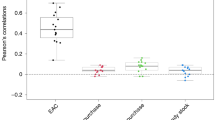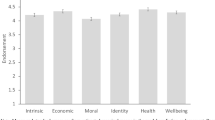Abstract
Environmental policies are often based on the assumption that people only act environmentally friendly if some extrinsic reward is implicated, usually money1,2. We argue that people might also be motivated by intrinsic rewards: doing the right thing (such as acting environmentally friendly) elicits psychological rewards in the form of positive feelings, a phenomenon known as warm glow3,4. Given the fact that people’s psychological state may affect their thermal state5,6, we expected that this warm glow could express itself quite literally: people who act environmentally friendly may perceive the temperature to be higher. In two studies, we found that people who learned they acted environmentally friendly perceived a higher temperature than people who learned they acted environmentally unfriendly. The underlying psychological mechanism pertains to the self-concept: learning you acted environmentally friendly signals to yourself that you are a good person. Together, our studies show that acting environmentally friendly can be psychologically rewarding, suggesting that appealing to intrinsic rewards can be an alternative way to encourage pro-environmental actions.
This is a preview of subscription content, access via your institution
Access options
Subscribe to this journal
Receive 12 print issues and online access
$209.00 per year
only $17.42 per issue
Buy this article
- Purchase on Springer Link
- Instant access to full article PDF
Prices may be subject to local taxes which are calculated during checkout




Similar content being viewed by others
References
Bolderdijk, J. W., Steg, L., Geller, E. S., Lehman, P. K. & Postmes, T. Comparing the effectiveness of monetary versus moral motives in environmental campaigning. Nature Clim. Change 3, 413–416 (2013).
Evans, L. et al. Self-interest and pro-environmental behaviour. Nature Clim. Change 3, 122–125 (2012).
Andreoni, J. Impure altruism and donations to public goods: A theory of warm-glow giving. Econ. J. 100, 464–477 (1990).
Andreoni, J. Warm-glow versus cold-prickle: The effects of positive and negative framing on cooperation in experiments. Q. J. Econ. 110, 1–21 (1995).
Zhong, C. B. & Leonardelli, G. J. Cold and lonely: Does social exclusion literally feel cold? Psychol. Sci. 19, 838–842 (2008).
Bargh, J. A. & Shalev, I. The substitutability of physical and social warmth in daily life. Emotion 12, 154–162 (2012).
Inagaki, T. K. & Eisenberger, N. I. Shared neural mechanisms underlying social warmth and physical warmth. Psychol. Sci. 24, 2272–2280 (2013).
Hsu, M., Anen, C. & Quartz, S. R. The right and the good: Distributive justice and neural encoding of equity and efficiency. Science 320, 1092–1095 (2008).
Thøgersen, J. & Ölander, F. The dynamic interaction of personal norms and environment-friendly buying behavior: A panel study. J. Appl. Soc. Psychol. 36, 1758–1780 (2006).
Bodner, R. & Prelec, D. in Collected Essays in Psychology and Economics (eds Brocas, I. & Carillo, J.) 1–22 (Oxford Univ. Press, 2003).
Dunning, D. Self-image motives and consumer behavior: How sacrosanct self-beliefs sway preferences in the marketplace. J. Consumer Psychol. 17, 237–249 (2007).
IJzerman, H. et al. Cold-blooded loneliness: Social exclusion leads to lower skin temperatures. Acta Psychol. 140, 283–288 (2012).
Schellen, L., Loomans, M. G. L. C., de Wit, M. H., Olesen, B. W. & Lichtenbelt, W. D. The influence of local effects on thermal sensation under non-uniform environmental conditions—Gender differences in thermophysiology, thermal comfort and productivity during convective and radiant cooling. Physiol. Behav. 107, 252–261 (2012).
Van Marken Lichtenbelt, W. D. et al. Evaluation of wireless determination of skin temperature using iButtons. Physiol. Behav. 88, 489–497 (2006).
MacKinnon, D. P., Fairchild, A. J. & Fritz, M. S. Mediation analysis. Annu. Rev. Psychol. 58, 593–614 (2007).
Van der Werff, E., Steg, L. & Keizer, K. The value of environmental self-identity: The relationship between biospheric values, environmental self-identity and environmental preferences, intentions and behaviour. J. Environ. Psychol. 34, 55–63 (2013).
Szymkow, A., Chandler, J., IJzerman, H., Parzuchowski, M. & Wojciszke, B. Warmer hearts, warmer rooms. Social Psychol. 44, 167–176 (2013).
Karjalainen, S. Consumer preferences for feedback on household electricity consumption. Energy Build. 43, 458–467 (2011).
Zapico, J. L., Guath, M. & Turpeinen, M. Kilograms or cups of tea: Comparing footprints for better CO2 understanding. PsychNology J. 9, 43–54 (2011).
Acknowledgements
This research was conducted as part of the INTEWON project (EOS LT 10033), funded by Agentschap NL.
Author information
Authors and Affiliations
Contributions
D.T. developed the study concept. All authors contributed to the study design. D.T. performed the data analysis and interpretation under the supervision of J.W.B. and L.S. D.T. drafted the manuscript, and J.W.B. and L.S. provided critical revisions. All authors approved the final version of the manuscript for submission.
Corresponding author
Ethics declarations
Competing interests
The authors declare no competing financial interests.
Rights and permissions
About this article
Cite this article
Taufik, D., Bolderdijk, J. & Steg, L. Acting green elicits a literal warm glow. Nature Clim Change 5, 37–40 (2015). https://doi.org/10.1038/nclimate2449
Received:
Accepted:
Published:
Issue Date:
DOI: https://doi.org/10.1038/nclimate2449
This article is cited by
-
Warming up cool cooperators
Nature Human Behaviour (2023)
-
To select effective interventions for pro-environmental behaviour change, we need to consider determinants of behaviour
Nature Human Behaviour (2022)
-
Effective carbon taxes need green nudges
Nature Climate Change (2022)
-
Leveraging social cognition to promote effective climate change mitigation
Nature Climate Change (2022)
-
Warm glow is associated with low- but not high-cost sustainable behaviour
Nature Sustainability (2018)



